Wetpixel coverage: DEMA 2014
From A ( Antelope Canyon) to Z (Zabriske Point )
A newbies impression of DEMA
By Mark Goyen
Following from my ten year old epiphany that not every great photograph is necessarily taken underwater, I had planned a 4 week landscape photography sojourn to the US south west, hence the title of this piece. I then discovered that DEMA was in in Vegas half way through November.

I have always wanted to go to DEMA. It always seemed cool that people would travel each year to promote a recreational activity that I have enjoyed for so many years. DEMA was where things happened, where new stuff was announced. The pointy end of diving with a very long history.
Trade shows have always been part of my working life. While working as a cosmetic surgeon I often travelled to the US (from Australia ) for trade conferences and seminars. Fourteen hour flights, Jet lag (lots of it), early morning starts, late finishes, no fresh air nor exposure to the sun. Surely DEMA couldn’t be like that….
So here I am, Vegas 2014 and the TUSA exhibit at the Las Vegas Convention Center has eight Elvis impersonators. Bring it on….
Adam Hanlon kindly invited me to help with the Wetpixel presence this year, in an unspecified capacity. Ok, I knew that I would get an invite to the cocktail party, but, that’s not all. And hey, this media badge really opens doors! People want to have their picture taken, their products looked over and they all have a story to tell.
So what was DEMA 2014 like for me?
There are many aspects to DEMA. Let’s start first with photography.
What was the central photographic theme of DEMA ? If 2014 had a theme it was about the democratisation of underwater photography. From what I saw this essentially means light weight, versatile technology which is relatively low cost. Smart phones and GoPro.
Smart phone cases were everywhere at the show. If you want to listen to music while swimming or snorkelling try the Dry Pouch
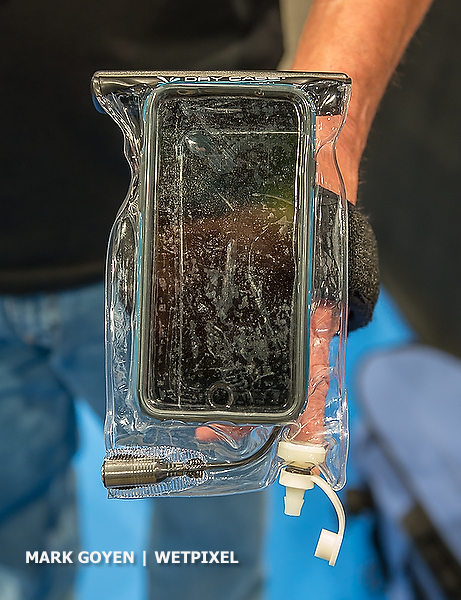
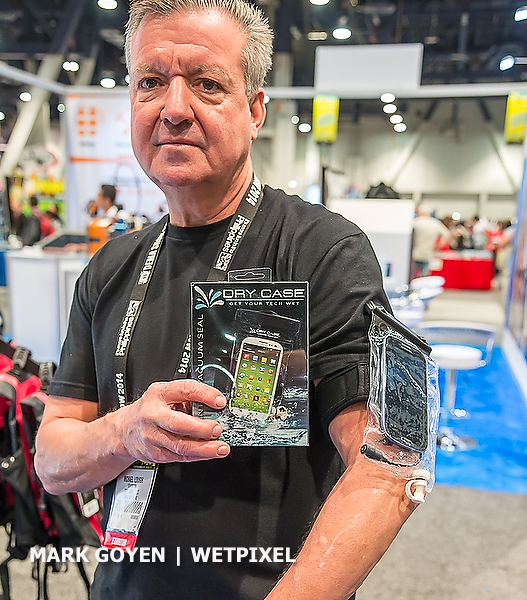
If you want to start using your smartphone underwater for photography then there are quite a few options as well. The PhotoProX comes with four screw in lenses for macro fisheye and telephoto and is rated to 33 feet. (Can it be much longer before a smart phone is a competitive substitute for a compact camera in a housing ?)
As well as a dSLR or mirrorless setup, many underwater photographers, myself included, have a smaller more compact second system in their rig. This is either to use either as a backup or more likely to do something different with (fisheye, macro or video). Smartphone cases may well prove an inexpensive answer to that age old dilemma of committing to a particular style of photography before every dive. Also, they may allow a simple entry into things such as surf photography, or simply be a convenient way to take people pics on dive boats etc.
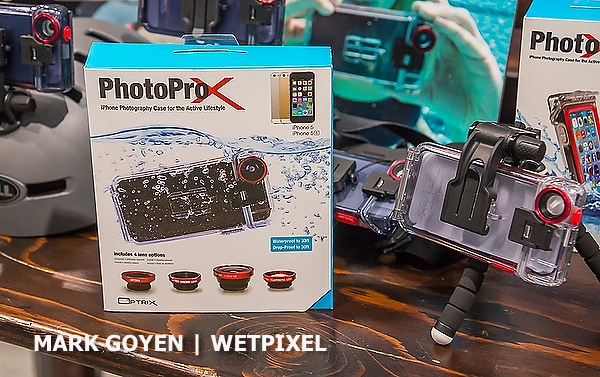
GoPro understandably had a substantial presence at DEMA. (They must have the largest market cap of anyone there, with the exception of Canon). I must admit that I think of my GoPro underwater as a way of extending my underwater photographic potential. Amazing footage was on display at their stand, but it was a video produce by Backscatter that showed the realistic potential of using a GoPro with appropriate red filters. As you can imagine there were lots of GoPro ad on accessories from third party manufacturers, but most without demonstration clips to determine the quality of many of the lenses.
A few weeks back, I ordered a Seacam D7100 housing. This was my fourth Seacam housing (the first for a Nikon F100 film body). I bought all of these through Michael Aw, but had never met Harald Hordosch, the man behind the Seacam brand. DEMA gave me that opportunity. It was great to meet him at the show and share his love of great design and passion for underwater photography.
Lots of other photo luminaries were at DEMA, of course, and it was great to meet many of them.
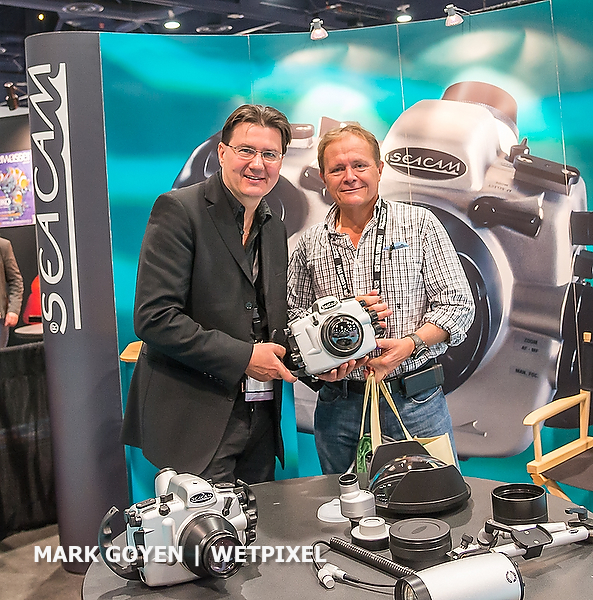
Getting a feel for different dSLR housings from magazines and even checking out other people’s gear on dive trips is difficult. At DEMA all the housings of the significant manufactures are within close proximity and it is much easier to assess build quality, housing control position, strobe mountings and general functionality. The same goes for viewfinders and dome ports. One thing that did strike me was that there seemed to be more urgency for manufacturers to get new housings out quicker. Great news. There were two Nikon D750 housings at the show.
Meeting old friends and dive travel buddies is an integral part of DEMA. Which leads me to dive travel. Lots to see here. Larger resorts and liveaboard operations had their own space. Sensibly, destinations such as Australia, Papua New Guinea, the Philippines and Indonesia comprised of numerous small dive resorts and liveaboards in the same larger booth. I visited some eight booths of places that I have already dived and I’m glad to say most seemed to be fairing well. Checking out potential new destinations is just as interesting as finding out what has been happening at visited resorts. There are lots of ideas for the future, in fact I visited a couple of booths of locations I’d already planned to dive in 2015.
DEMA is about much more than photography and travel. Dive equipment manufacturers certainly outnumber photographic booths and many take up quite a lot of floor space. Most major manufacturers were represented and a lot of the TUSA people dressed up as Elvis, at least on the first day. I didn’t even know that Elvis was a diver. Maybe he submerges in the director’s cut of Blue Hawaii.
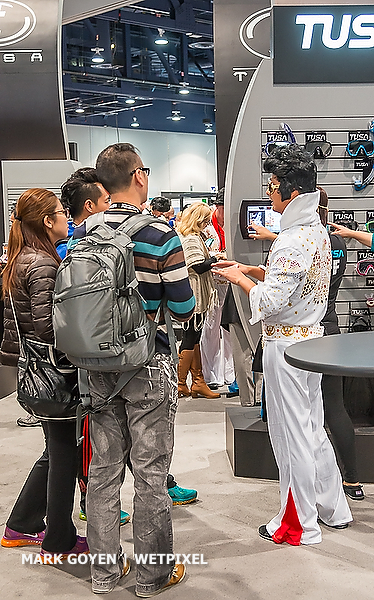
Dive equipment wise, I would have difficulty commenting on what is new. New concepts to me were active in-wetsuit heating devices (electrical and chemical), which looked promising, compact rebreather systems, custom made high end dry suits and some well designed new dive computers.
One product which I really thought was promising was a newly designed snorkel by Dr. Mark Johnson of Kapitol Reef Aquatics. It is designed to be dry.sure… but it is also designed to use PEEP ( positive end expiratory pressure ) to improve oxygen uptake and carbon dioxide removal. Added benefits are improved respiratory dynamics. With photographers spending lots of time on snorkel chasing sharks, crocodiles, whales and dolphins on snorkel, anything that can improve surface breathing comfort and hopefully breath hold diving performance is worth a look. I bought one and will certainly give it a work out.
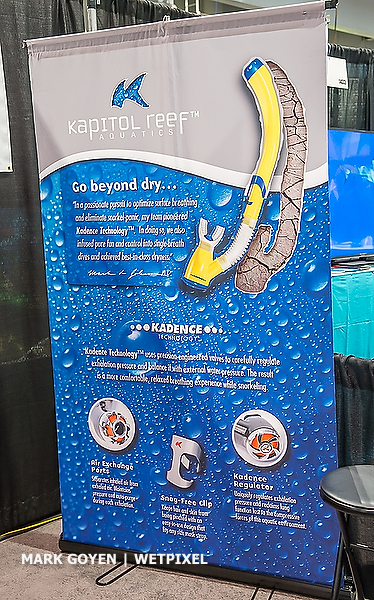
During a long past phase of my medical career, I was involved in underwater medicine and spent a lot of time advising dive industry personal on many aspects of dive medicine. So I had to attend some of the DAN seminars. They were great. Wide ranging subjects, directed at people very interested in dive medicine, they covered a diverse range of topics. “ Bubbles and Diving: Fact and Fallacies “ was a great insight into contemporary understanding of diving physiology. Some great take home messages too….if you want to avoid DCS.

Divers are getting older. Many of the DAN topics look at some age and lifestyle related problems and chronic illness and disability in divers. Photographers are divers too, I just wish I could focus closer to my macro subjects. Don’t worry, I have thought of having LASIK.
In a similar vein, there were three booths selling TENS machine to help with neck, back and everywhere else pain. Two booths selling massage chairs. Despite the thick carpet on most of the exhibition room floor, the chairs looked very inviting after four to five hours of looking at photographic and diving stuff.
Meanwhile back to photography. There is a lot of peripheral activity at DEMA apart from the main exhibition area. Many of these were upstairs, but thankfully the Image Photo Resource Seminars were not. Yes, it was a little noisy and some of the talks were standing room only, but there was good variety and a lot of topics and levelled covered. I particularly enjoyed Erin Quigley’s presentations on Lightroom with forays into Photoshop. For me they passed the Lightroom/Photoshop interest test by which I mean I learnt at least two really cool new things about these tools from any one session. Adam Hanlon recorded Ron Lagerlof’s “Not all 4K is 4K” session and hopefully it will air soon.
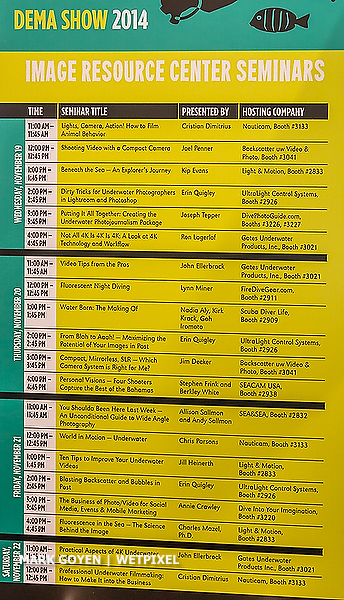
My favourite exhibitor was Mermaid Linden who spent the whole show ( or at least the first two days ) in her mermaid outfit. And yes, she spent a lot of the time on her shell phone, with coral waiting and voice whale.
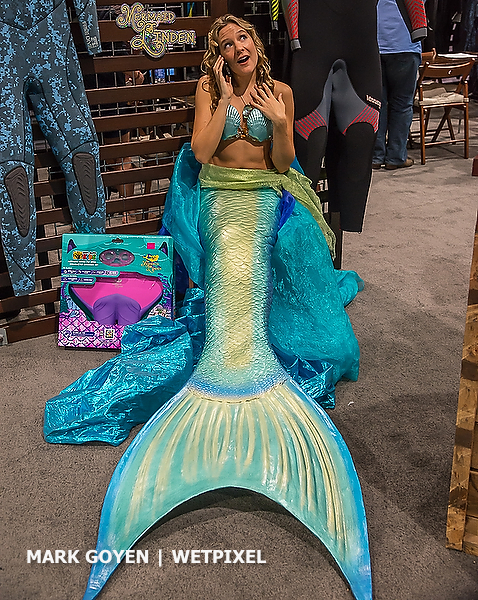
Anyway, that’s enough for now. DEMA was great and worth a dive. Anyway…. I’m off to the Wetpixel cocktail party !!
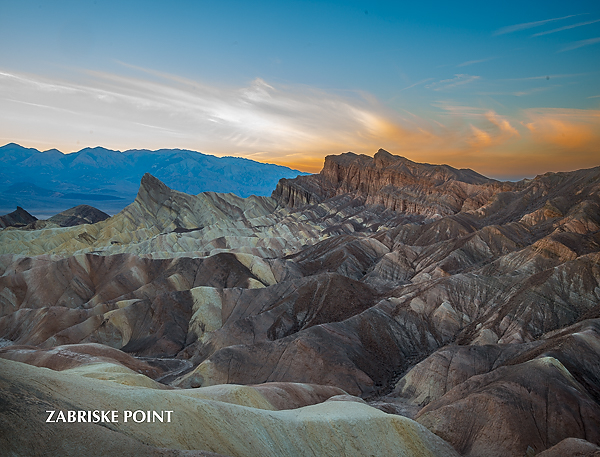
About the author:
Mark Goyen has been an underwater photographer since forever. His images can be seen on his website.
He has recently published an ebook called TEN. Ten years of digital photography, available from the site for $4.95.
ALL the proceeds from the book are donated to breast cancer research.
Booth visits day 1: Backscatter, GoPro, Keldan, Ikelite, Subal.
Booth visits day 2: H20 Tools, 10 Bar, Seacam, PolarPro, Aquatica, Nauticam, Acquapazza.
Day 2: Wetpixel/DivePhotoGuide Underwater Imaging Party.
Booth visits day 3: New World Publications, Sea& Sea, Gates, Light & Motion, Watershot, Inon.
Booth visits day 4: Saga, ULCS, Aquatica, BS Kinetics, Fantasea, Orcalight, XIT404, iDive.
Mark Goyen: A newbie’s impression of DEMA.
Steve Williams: Final thoughts on DEMA 2014.
Adam Hanlon: Finishing thoughts and round up.